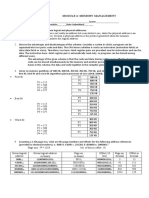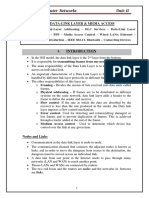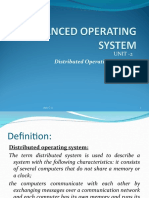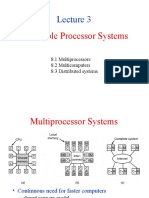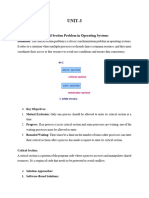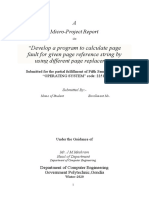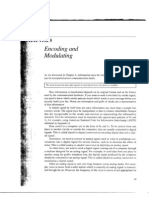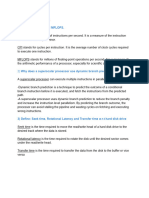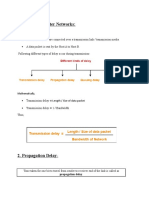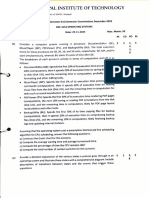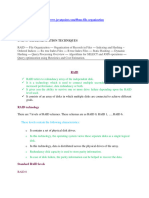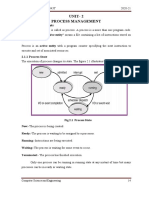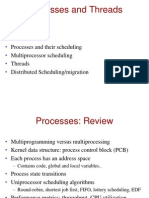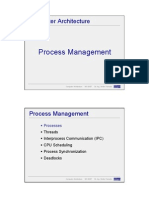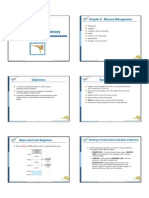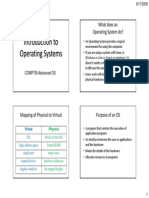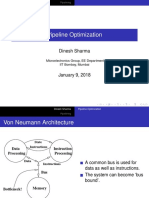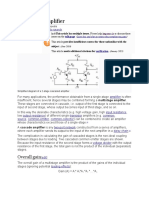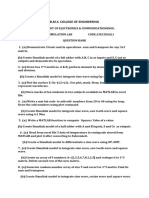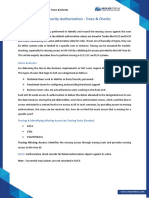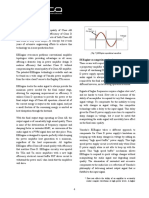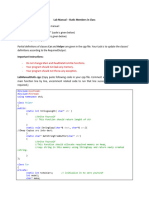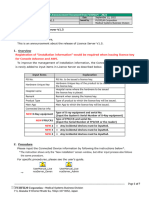Scheduling
On a uniprocessor system there is only one process running, all others have to wait until they are scheduled. They are waiting in some scheduling queue:
Processes
Job Queue
Holds the future processes of the system.
Ready Queue (also called CPU queue)
Holds all processes that reside in memory and are ready to execute.
Device Queue (also called I/O queue)
Each device has a queue holding the processes waiting for I/O completion.
IPC Queue
Holds the processes that wait for some IPC (inter process communication) event to occur.
Computer Architecture
WS 06/07
Dr.-Ing. Stefan Freinatis
Scheduling
Processes
Ready queue
Tape
These queues are empty Device queues
Ethernet
registers registers registers
Disk
Terminal
registers
The ready queue and some device queues
Figure from [Sil00 p.92], modified
Computer Architecture
WS 06/07
Dr.-Ing. Stefan Freinatis
�Scheduling
From the job queue a new process is initially put into the ready queue. It waits until it is dispatched (selected for execution). Once the process is allocated the CPU, one of these events may occur.
Processes
Interrupt
The time slice may be expired or some higher priority process is ready. Hardware error signals (exceptions) also may cause a process to be interrupted.
I/O request
The process requests I/O. The process is shifted to a device queue. After the I/O device has ready, the process is put into the ready queue to continue.
IPC request
The process wants to comunicate with another process through some blocking IPC feature. Like I/O, but here the I/O-device is another process.
A note on the terminology: Strictly spoken, a process (in the sense of an active entity) only exists when it is allocated the CPU. In all other cases it is a dead body.
Computer Architecture WS 06/07 Dr.-Ing. Stefan Freinatis
Scheduling
Processes processes are ready process is running
Job queue
Ready queue
CPU
Interrupt I/O request events IPC request
processes are new
Device queue
processes are waiting
IPC queue
Queueing diagram of process scheduling
Computer Architecture WS 06/07 Dr.-Ing. Stefan Freinatis
�Scheduling
The OS selects processes from queues and puts them into other queues. This selection task is done by schedulers.
Processes
Long-term Scheduler
Originates from batch systems. Selects jobs (programs) from the pool and loads them into memory. Invoked rather infrequently (seconds ... minutes). Can be slow. Has influence on the degree of multiprogramming (number of processes in memory). Some modern OS do not have a long-term scheduler any more.
Short-term Scheduler
Selects one process from among the processes that are ready to execute, and allocates the CPU to it. Initiates the context switches. Invoked very frequently (in the range of milliseconds). Must be fast, that is, must not consume much CPU time compared to the processes.
Computer Architecture WS 06/07 Dr.-Ing. Stefan Freinatis
Scheduling
Processes
Long-term scheduler
Short-term scheduler
Job queue
Ready queue
CPU
Schedulers and their queues
Computer Architecture WS 06/07 Dr.-Ing. Stefan Freinatis
�Scheduling
Sometimes it may be advantageous to remove processes temporarily from memory in order to reduce the degree of multiprogramming. At some later time the process is reintroduced into memory and can be continued. This scheme is called swapping, performed by a medium-term scheduler.
Job queue
Processes
Ready queue
swap out
CPU
Medium-term scheduler
swap in
swap queue
Computer Architecture
WS 06/07
Dr.-Ing. Stefan Freinatis
Process Concept
Program in execution
Several processes may be carried out in parallel. Processes
Resource grouping
Each process is related to a certain task and groups together the required resources (Address space, PCB).
Traditional multi-processing systems:
Each process is executed sequentially
No parallelism inside a process.
Blocked operations Blocked process
Any blocking operation (e.g. I/O, IPC) blocks the process. The process must wait until the operation finishes.
In traditional systems each process has a single thread of control.
Computer Architecture WS 06/07 Dr.-Ing. Stefan Freinatis
�Process Management
� Processes � Threads � Interprocess Communication (IPC) � CPU Scheduling � Deadlocks
Computer Architecture
WS 06/07
Dr.-Ing. Stefan Freinatis
Threads
A thread is a piece of yarn, a screw spire, a line of thoughts. Here: a sequence of instructions
that may execute in parallel with others A thread is a line of execution within the scope of a process. A single threaded process has a single line of execution (sequential execution of program code), the process and the thread are the same. In particular, a thread is
a basic unit of CPU utilization.
Computer Architecture WS 06/07 Dr.-Ing. Stefan Freinatis
�Threads
Three single threaded processes in parallel
A process with three parallel threads.
Figure from [Ta01 p.82]
Computer Architecture
WS 06/07
Dr.-Ing. Stefan Freinatis
Threads
As an example, consider of a word processing application.
Reading from keyboard Formatting and displaying pages Periodically saving to disk ... and lots of other tasks
A single threaded process would quite quickly result in an unhappy user since (s)he always has to wait until the current operation is finished.
� Multiple processes?
Each process would have its own isolated address space.
� Multiple threads!
The threads operate in the same address space and thus have access to the data.
Computer Architecture WS 06/07 Dr.-Ing. Stefan Freinatis
�Threads
Three-threaded word processing application
formatting and displaying
Reading keyboard
Saving to disk
Figure from [Ta01 p.86] Computer Architecture WS 06/07 Dr.-Ing. Stefan Freinatis
Threads
Multiple executions in same environment
All threads have exactly the same address space (the process address space).
Each thread has own registers, stack and state
Figure from [Sil00 p.116] Computer Architecture WS 06/07 Dr.-Ing. Stefan Freinatis
�Threads
Items shared by all threads in a process Items private to each thread
Table from [Ta01 p.83] Computer Architecture WS 06/07 Dr.-Ing. Stefan Freinatis
User Level Threads
Threads
Take place in user space
The operating system does not know about the applications internal multi-threading.
Can be used on OS not supporting threads
It only needs some thread library (like pthreads) linked to the application.
Each process has its own thread table
The table is maintained by the routines of the thread library.
Customized thread scheduling
The processes use their own thread scheduling algorithm. However, no timer controlled scheduling possible since there are no clock interrupts inside a process.
Blocking system calls do block the process
All threads are stopped because the process is temporarily removed from the CPU.
Computer Architecture WS 06/07 Dr.-Ing. Stefan Freinatis
�User Level Threads
Threads
Thread management is performed by the application.
Examples - POSIX Pthreads - Mach C-threads - Solaris threads
Figure from [Ta01 p.91] Computer Architecture WS 06/07 Dr.-Ing. Stefan Freinatis
Kernel Threads
Take place in kernel
The operating system manages the threads of each process Threads
Available only on multi-threaded OSs
The operating system must support multi-threaded application programs.
No thread administration inside process
since this is done by the kernel. Thread creation and management however is generally somewhat slower than with user level threads [Sil00 p.118].
No customized scheduling
The user process cannot use its own customized scheduling algorithm.
No problem with blocking system calls
A blocking system call causes a thread to pause. The OS activates another thread, either from the same process or from another process.
Computer Architecture
WS 06/07
Dr.-Ing. Stefan Freinatis
�Kernel Threads
Threads
Thread management is performed by the operating system.
Examples - Windows 95/98/NT/2000 - Solaris - Tru64 UNIX - BeOS - Linux
Figure from [Ta01 p.91] Computer Architecture WS 06/07 Dr.-Ing. Stefan Freinatis
Multithreading Models
Many-to-One Model
Threads
Many user level threads are mapped to a single kernel thread. Used on systems that do not support kernel threads.
Figure from [Sil00 p.118] Computer Architecture WS 06/07 Dr.-Ing. Stefan Freinatis
�Multithreading Models
One-to-One Model
Threads
Each user level thread is mapped to one kernel thread.
Figure from [Sil00 p.119] Computer Architecture WS 06/07 Dr.-Ing. Stefan Freinatis
Multithreading Models
Many-to-Many Model
Threads
Many user level threads are mapped to many kernel threads.
Figure from [Sil00 p.119] Computer Architecture WS 06/07 Dr.-Ing. Stefan Freinatis
�Multithreading
Solaris 2 multi-threading example
Threads
Figure from [Sil00 p.121] Computer Architecture WS 06/07 Dr.-Ing. Stefan Freinatis
Threads
Windows 2000: Implements one-to-one mapping
Each thread contains - a thread id - register set - separate user and kernel stacks - private data storage area
Linux:
One-to-one model (pthreads), many-to-many (NGPT) Thread creation is done through clone() system call.
clone() allows a child to share the address space of the parent. This system call is unique to Linux, source code not portable to other UNIX systems.
Computer Architecture WS 06/07 Dr.-Ing. Stefan Freinatis
�Threads
Java: Provides support at language level.
Thread scheduling in JVM
class Worker extends Thread { public void run() { System.out.println("I am a worker thread"); } }
Example: Creation of a thread by inheriting from Thread class
public class MainThread { public static void main(String args[]) { Worker worker1 = new Worker(); worker1.start(); System.out.println("I am the main thread"); } thread creation and automatic call of run() method }
Computer Architecture WS 06/07 Dr.-Ing. Stefan Freinatis
Process Management
� Processes � Threads � Interprocess Communication (IPC) � CPU Scheduling � Deadlocks
Computer Architecture
WS 06/07
Dr.-Ing. Stefan Freinatis
�IPC
Purpose of Inter Process Communication
Managing critical activities
Making sure that two (or more) processes do not get into each others' way when engaging critical activities.
Sequencing
Making sure that proper sequencing is assured in case of dependencies among processes.
Process Synchronization
Thread Synchronization
Passing information
Processes are independent of each other and have private address spaces. How can a process pass information (or data) to another process?
Data exchange
Computer Architecture
Less important for threads since they operate in the same environment
WS 06/07 Dr.-Ing. Stefan Freinatis
Race Conditions
Print spooling example
IPC
shared variables
next empty slot
Figure from [Ta01 p.101]
Situations, where two or more processes access some shared resource, and the final result depends on who runs precisely when, are called race conditions.
Computer Architecture WS 06/07 Dr.-Ing. Stefan Freinatis
�Race Conditions
� Processes A and B want to print a file � Both have to enter the file name into a spooler directory � out points to the next file to be printed. This variable is accessed only by the printer daemon. The daemon currently is busy with slot 4. � in points to the next empty slot. Each process entering a file name in the empty slot must increment in.
Now consider this situation:
IPC
� Process A reads in (value = 7) into some local variable. Before it can continue, the CPU is switched over to B. � Process B reads in (value = 7) and stores its value locally. Then the file name is entered into slot 7 and the local variable is incremented by 1. Finally the local variable is copied to in (value = 8). � Process A is running again. According to the local variable, the file name is entered into slot 7 erasing the file name put by B. Finally in is incremented. � User B is waiting in the printer room for years ...
Computer Architecture WS 06/07 Dr.-Ing. Stefan Freinatis
Race Conditions
Another example at machine instruction level Shared variable x (initially 0)
IPC
Process 1
R1 � x R1 = R1+1 R1 � x
Process 2
x=0 x=1
Process 1
R1 � x
Process 2
x=0
R3 � x R3 = R3+1 R1 = R1+1 R1 � x R3 � x
R3 � x R3 = R3+1 R3 � x
x=2
x=1
Scenario 1
Scenario 2
Computer Architecture
WS 06/07
Dr.-Ing. Stefan Freinatis
�Critical Regions
How to avoid race conditions? Find some way to prohibit more than one process from manipulating the shared data at the same time.
IPC
Mutual exclusion
Part of the time a process is doing some internal computations and other things that do not lead to race conditions. Sometimes a process however needs to access shared resources or does other critical things that may lead to race conditions. These parts of a program are called critical regions (or critical sections).
critical region Process A
t
WS 06/07 Dr.-Ing. Stefan Freinatis
Computer Architecture
Critical Regions
IPC
Four conditions to provide correctly working mutual exclusion:
1. No two processes simultaneously in critical region
which would otherwise controvert the concept of mutuality.
2. No assumptions about process speeds
No predictions on process timings or priorities. Must work with all processes.
3. No process outside its critical regions must block other processes, simply because there is no reason to hinder
others entering their critical region.
4. No process must wait forever to enter a critical region.
For reasons of fairness and to avoid deadlocks.
Computer Architecture
WS 06/07
Dr.-Ing. Stefan Freinatis
�Critical Regions
Mutual exclusion using critical regions
IPC
Figure from [Ta01 p.103] Computer Architecture WS 06/07 Dr.-Ing. Stefan Freinatis
Mutual Exclusion
Proposals for achieving mutual exclusion
IPC
Disabling interrupts
The process disables all interrupts and thus cannot be taken away from the CPU.
� Not appropriate. Unwise to give user process full control over computer.
Lock variables
A process reads a shared lock variable. If the lock it is not set, the process sets the variable (locking) and uses the resource.
� In the period between evaluating and setting the variable the process may be interrupted. Same problem as with printer spooling example.
Computer Architecture WS 06/07 Dr.-Ing. Stefan Freinatis
�Mutual Exclusion
Proposals for achieving mutual exclusion (continued)
IPC
Strict Alternation
The shared variable turn keeps track of whose turn it is. Both processes alternate in accessing their critical regions.
while (1) { while (turn != 0); critical_region(); turn = 1; noncritical_region(); }
Process 0
while (1) { while (turn != 1); critical_region(); turn = 0; noncritical_region(); }
Process 1
Computer Architecture
WS 06/07
Dr.-Ing. Stefan Freinatis
Mutual Exclusion
Proposals for achieving mutual exclusion (continued)
IPC
Strict Alternation (continued)
� Busy waiting wastes CPU time. � No good idea when one process is much slower than the other. � Violation of condition 3.
busy waiting for turn = 0 Process 0 Process 1
t
turn = 0 turn = 1 turn = 0
Computer Architecture
WS 06/07
Dr.-Ing. Stefan Freinatis
�Mutual Exclusion
Proposals for achieving mutual exclusion (continued)
IPC
Peterson Algorithm
int turn; bool interested[2];
shared variables Two processes, number is either 0 or 1
void enter_region(int process) { int other = 1 process; interested[process] = TRUE; turn = process; while (turn == process && interested[other] == TRUE); } void leave_region(int process) { interested[process] = FALSE; }
Computer Architecture WS 06/07 Dr.-Ing. Stefan Freinatis
Mutual Exclusion
Peterson Algorithm (continued)
IPC
Assume process 0 and 1 both simultaneously entering critical_region() other = 1 interested[0] = true turn = 0 other = 0 interested[1] = true turn = 1
Process 0
Both are manipulating turn at the same time. Whichever store is last is the one that counts. Assume process 1 was slightly later, thus turn = 1. while (turn == 0 && interested[1] == TRUE); while (turn == 1 && interested[0] == TRUE); Process 0 passes its while statement, whereas process 1 keeps busy waiting therein. Later, when process 0 calls leave_region(), process 1 is released from the loop.
� Good working algorithm, but uses busy waiting
Computer Architecture WS 06/07
Process 1
Dr.-Ing. Stefan Freinatis
�Mutual Exclusion
Proposals for achieving mutual exclusion (continued)
IPC
Test and Set Lock (TSL)
Atomic operation at machine level. Cannot be interrupted. TSL reads the content of the memory word lock into register R and then stores a nonzero value at the memory address lock. The memory bus is locked, no other process(or) can access lock.
enter_region:
TSL R, lock CMP R, #0 JNZ enter_region RET MOV lock, #0 RET
indivisible operation
� CPU must support TSL � Busy waiting
leave_region:
Pseudo assembler listing providing the functions enter_region() and leave_region().
Computer Architecture WS 06/07 Dr.-Ing. Stefan Freinatis

